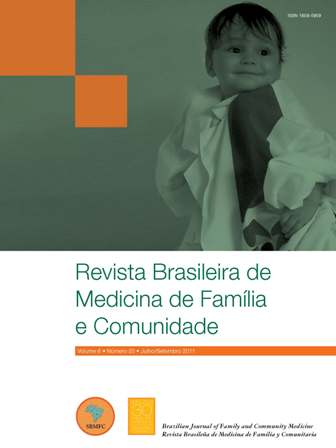Smoking: the perception of smokers on a health education group
DOI:
https://doi.org/10.5712/rbmfc6(20)216Keywords:
Smoking, Primary Health Care, Health Education, Risk Factors, Family HealthAbstract
This is a qualitative study which aimed to understanding the meaning of anti-smoking groups developed in a unit of Family Health Care in the city of Montes Claros, in Minas Gerais State. The action-research was used as a theoretical and methodological reference. The subjects were smokers who experienced group sessions on health education. The data collection tools were: the non-participant observation, the participant observation, and the semi-structured interviews. The collected data were submitted to the technique of discourse analysis with the identification of two categories: the meaning of smoking and the meaning of anti-smoking support groups in the perception of the subjects who were part of the group. Smokers expressed ideas and feelings as well as the representation of the cigarette. This study showed the relevance of support groups during the process of quitting smoking, and the need of better professional training and service structure in order to face the problem. This study was also a way to promote the anti-smoking treatment in the public health system and its impact on the population who had this benefit, being a parameter and encouragement for other scenarios.
Downloads
Metrics
References
Ministério da Saúde (BR). Instituto Nacional do Câncer. Estimativas de incidência e mortalidade por câncer no Brasil. Rio de Janeiro: Ministério da Saúde; 2003.
Mathers CD, Loncar D. Projections of global mortality and burden of desease from 2022 a 2030. PloS Med. 2006; 3(11): 442. http://dx.doi.org/10.1371/journal.pmed.0030442 DOI: https://doi.org/10.1371/journal.pmed.0030442
Ministério da Saúde (BR). Portaria 1886/GM. Anexo 1 - Normas e diretrizes do Programa de Agentes Comunitários de Saúde - PACS. Brasília: Ministério da Saúde; 1997.
Wannmacher L. Tratamento medicamentoso antitabagismo. Uso Racional de Medicamentos: temas selecionados. 2007; 4(4): 1-6.
Oliveira MC. Os modelos de cuidados como eixo de estruturação de atividades interdisciplinares e multiprofissionais em saúde. Rev Bras Educ Méd. 2008; 32(3): 347-55. http://dx.doi.org/10.1590/S0100-55022008000300009 DOI: https://doi.org/10.1590/S0100-55022008000300009
Thiollent M. Metodologia da pesquisa-ação. 12ª ed. São Paulo: Cortez; 2003.
Marques JB, Aprígio DP, Mello HLS, Silva JD, Pinto LN, Machado DCD, et al. Contribuições da equipe multiprofissional de saúde no programa saúde da família (PSF): uma atualização da literatura. Rev Baiana Saúde Pública. 2007; 31(2): 246-55.
Minayo MCS. O desafio do conhecimento. 5ª ed. São Paulo: Hucitec; 1998.
Ministério da Saúde (BR). Instituto Nacional do Câncer. Coordenação de prevenção e vigilância (CONPREV). Abordagem e tratamento do fumante. Rio de Janeiro: INCA; 2001.
Fagerström KO. Measuring degree of physical dependence to tobacco smoking with reference to individualization of treatment. Addict Behav. 1978; 3(3-4): 235-41. http://dx.doi.org/10.1016/0306-4603(78)90024-2 DOI: https://doi.org/10.1016/0306-4603(78)90024-2
Borges MTT, Simões-Barbosa RH. Cigarro “companheiro”: o tabagismo feminino em uma abordagem crítica de gênero. Cad Saúde Pública. 2008; 24(12): 2834-42. http://dx.doi.org/10.1590/S0102-311X2008001200012 DOI: https://doi.org/10.1590/S0102-311X2008001200012
Malbergier A, Oliveira Júnior HP. Dependência de tabaco e comorbidade psiquiátrica. Rev Psiq Clin. 2005; 32(5): 276-82. http://dx.doi.org/10.1590/S0101-60832005000500005 DOI: https://doi.org/10.1590/S0101-60832005000500005
Focchi GR, Malbergier A, Ferreira MP. Tabagismo: dos fundamentos ao tratamento. São Paulo: Lemos; 2006.
Echer IC, Barreto SSM. Determinação e apoio como fatores de sucesso no abandono do tabagismo. Rev Latino-Am Enfermagem. 2008; 16(3): 445-51. http://dx.doi.org/10.1590/S0104-11692008000300018 DOI: https://doi.org/10.1590/S0104-11692008000300018
Leitão Filho FS, Galduróz JCF, Noto AR, Nappo AS, Carlini EA, Nascimento AO, et al. Levantamento randomizado sobre a prevalência do tabagismo nos maiores municípios do Brasil. J Bras Pneumol. 2009; 35(12): 1204-11. DOI: https://doi.org/10.1590/S1806-37132009001200007
Dórea AJP, Botelho C. Fatores dificultadores da cessação do tabagismo. J Bras Pneumol. 2004; 30(2): 41-6.
Sardinha A, Oliva AD, D’augustin J, Ribeiro F, Falcone EMO. Intervenção cognitivo-comportamental com grupos para o abandono do cigarro. Rev Bras Ter Cogn. 2005; 1(1): 83-90.
Mazoni CG, Fernandes S, Pierozan OS, Moreira T, Freese L, Ferigolo M, et al. A eficácia das intervenções farmacológicas e psicossociais para o tratamento do tabagismo: revisão da literatura. Estud Psicol (Natal). 2008; 13(2): 133-40. http://dx.doi.org/10.1590/S1413-294X2008000200005 DOI: https://doi.org/10.1590/S1413-294X2008000200005
Cahill K, Moher M, Lancaster T. Workplace interventions for smoking cessation. Cochrane Database of Systematic Reviews. 2008; (4): CD003440. DOI: 10.1002/14651858.CD003440.pub3. DOI: https://doi.org/10.1002/14651858.CD003440.pub3
Hortense FTP, Carmagnani MIS, Brêtas ACP. O significado do tabagismo no contexto do câncer de laringe. Rev Bras Enferm. 2008; 61(1): 24-30. http://dx.doi.org/10.1590/S0034-71672008000100004 DOI: https://doi.org/10.1590/S0034-71672008000100004
Mattos MHO, Silva LA, Franken RA. Tabagismo no currículo da faculdade de ciências médicas de São Paulo. Rev Bras Educ Med. 2009; 33(1): 33-9. http://dx.doi.org/10.1590/S0100-55022009000100005 DOI: https://doi.org/10.1590/S0100-55022009000100005
Roddy E, Rubin P, Britton J. A study of smoking and smoking cessation on the curricula of UK medical schools. Tob Control. 2004; 13: 74-7. http://dx.doi.org/10.1136/tc.2003.004572 DOI: https://doi.org/10.1136/tc.2003.004572
Oliveira NA, Alves LA, Luz MR. Iniciação científica na graduação: o que diz o estudante de medicina? Rev Bras Educ Med. 2008; 32(3): 309-14. http://dx.doi.org/10.1590/S0100-55022008000300005 DOI: https://doi.org/10.1590/S0100-55022008000300005
Andreson MIP, Demarzoe MMP, Rodrigues RD. A medicina de família e comunidade, a atenção primária à saúde e o ensino de graduação: recomendações e potencialidades. Rev Bras Med Fam Com. 2007; 3(11): 157-72. DOI: https://doi.org/10.5712/rbmfc3(11)334
Downloads
Published
How to Cite
Issue
Section
License
By submitting a manuscript to the RBMFC, authors retain ownership of the copyright in the article, and authorize RBMFC to publish that manuscript under the Creative Commons Attribution 4.0 license and identify itself as the vehicle of its original publication.















